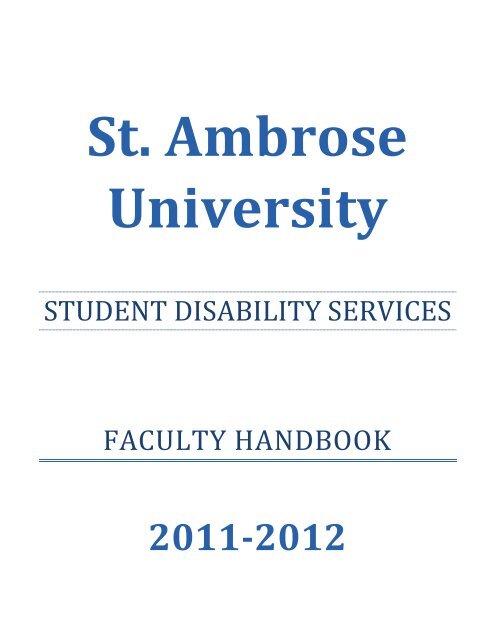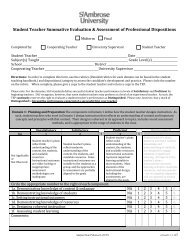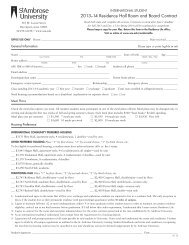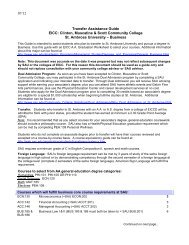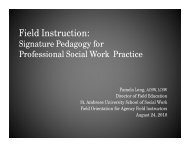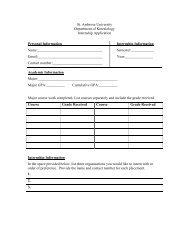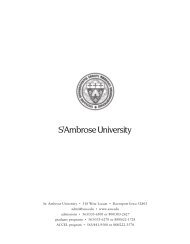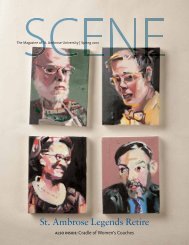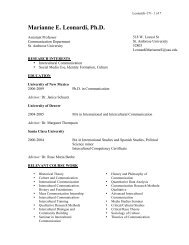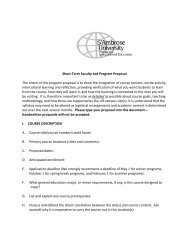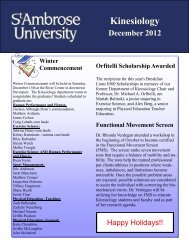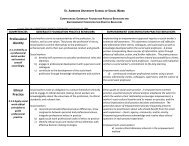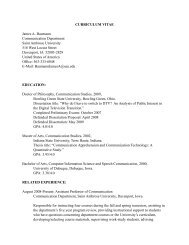student disability services faculty handbook - St. Ambrose University
student disability services faculty handbook - St. Ambrose University
student disability services faculty handbook - St. Ambrose University
Create successful ePaper yourself
Turn your PDF publications into a flip-book with our unique Google optimized e-Paper software.
<strong>St</strong>. <strong>Ambrose</strong><br />
<strong>University</strong><br />
STUDENT DISABILITY SERVICES<br />
FACULTY HANDBOOK<br />
2011-2012
TABLE OF CONTENTS<br />
SDS Directory........................................................................................................................ 2<br />
Disabilities and the Law………………………………………………………………………. 3<br />
Classification of Disabilities…………………………………………………………………. 4<br />
Acquired Brain Injury<br />
Attention<br />
Learning<br />
Mobility<br />
Pervasive Developmental<br />
Psychiatric<br />
Sensory<br />
Systemic<br />
Person-first Language…………………………………………………………………………. 7<br />
Syllabus <strong>St</strong>atements …………………………………………………………………………… 7<br />
SAU Rights and Responsibilities…………………………………………………………… 8<br />
<strong>St</strong>udents’ Rights and Responsibilities…………………………………………………… 10<br />
Common Accommodations………………………………………………………………….. 11<br />
Alternative Exams<br />
Note-taking<br />
Assignment Accommodations<br />
Print Material<br />
Course Substitutions<br />
Universal Design for Learning……………………………………………………………… 14<br />
Frequently Asked Questions………………………………………………………………… 15<br />
Appendix<br />
Guidelines for Working with <strong>St</strong>udents with Hearing Impairments<br />
Guidelines for Working with an Interpreter<br />
Instructional <strong>St</strong>rategies for <strong>St</strong>udents with LD<br />
2011-2012 <strong>St</strong>udent Disability Services Faculty Handbook<br />
1
STUDENT DISABILITY SERVICES DIRECTORY<br />
Ryan Saddler (563) 333-6275<br />
Director<br />
saddlerryanc@sau.edu<br />
Beth Cook (563) 333-6477<br />
Learning Disabilities Specialist<br />
cookbeth@sau.edu<br />
Carol McCoy (563) 333-6029<br />
Learning Disabilities Specialist<br />
mccoycarolj@sau.edu<br />
Jean Hess (563) 333-5878<br />
Administrative Assistant<br />
hessjeanl@sau.edu<br />
Graduate Assistants<br />
(563) 333-5878 or<br />
(563) 333-6275<br />
Dr. Andy Kaiser (563) 333-6479<br />
Professor, Psychology<br />
kaiserandrewj@sau.edu<br />
ADA Advisor / Disabilities Specialist<br />
Dr. Tracy Schuster-Matlock (563) 333-6049<br />
Associate Dean of <strong>University</strong> Academic Programs<br />
schustertracy@sau.edu<br />
2011-2012 <strong>St</strong>udent Disability Services Faculty Handbook<br />
2
THE MISSION OF STUDENT DISABILITY SERVICES<br />
The <strong>St</strong>udent Disability Services office (SDS) provides qualified <strong>student</strong>s with disabilities <strong>services</strong> or<br />
reasonable accommodations intended to facilitate the <strong>student</strong>'s full participation at <strong>St</strong>. <strong>Ambrose</strong><br />
<strong>University</strong>. Services do not lower course standards or alter degree requirements, but <strong>services</strong><br />
include appropriate academic adjustments and modifications to allow for full participation by<br />
<strong>student</strong>s. <strong>St</strong>. <strong>Ambrose</strong> <strong>University</strong> will not discriminate against any <strong>student</strong> based on any <strong>disability</strong>.<br />
DISABILITIES AND THE LAW<br />
Two primary pieces of legislation were enacted to protect the rights of individuals with disabilities.<br />
Section 504 of the Rehabilitation Act of 1973, as amended, states that no otherwise qualified<br />
individual with a <strong>disability</strong> may be discriminated against or denied access to the benefits or <strong>services</strong><br />
of any program or activity receiving federal financial assistance. The Americans with Disabilities<br />
Act (ADA), which became effective January 26, 1992, and the Americans with Disabilities Act<br />
Amendments Act (ADAAA) of 2008, prohibit colleges and universities from discriminating against<br />
qualified <strong>student</strong>s with disabilities.<br />
<strong>St</strong>. <strong>Ambrose</strong> <strong>University</strong> is committed to complying with these laws by providing reasonable<br />
accommodations and appropriate academic adjustments and modifications to qualified individuals<br />
with disabilities. A “reasonable accommodation” includes any auxiliary aids and <strong>services</strong>, which do<br />
not fundamentally alter the nature of a program or course and do not create an undue burden upon<br />
the <strong>University</strong>. An “individual with a <strong>disability</strong>” is someone who has a physical or mental<br />
impairment that substantially limits one or more major life activity, has a record of such<br />
impairment, or is regarded as having such impairment. An “otherwise qualified individual with a<br />
<strong>disability</strong>” is a person who, with or without reasonable accommodations, can meet the essential<br />
program or course requirements.<br />
The Director of the SDS office is responsible for ensuring that otherwise qualified <strong>student</strong>s with<br />
disabilities are provided with reasonable accommodations, academic adjustments and<br />
modifications, and have an equal opportunity to succeed. The Director of SDS is accountable for<br />
maintaining the integrity of the office by complying with Section 504 and the ADA/ADAAA,<br />
determining eligibility for <strong>services</strong>, and maintaining appropriate documentation.<br />
Back to Table of Contents<br />
2011-2012 <strong>St</strong>udent Disability Services Faculty Handbook<br />
3
CLASSIFICATION OF DISABILITIES<br />
The SDS Office categorizes disabilities according to the following structure.<br />
ACQUIRED BRAIN INJURY (ABI)<br />
ABI occurs when a sudden, external, physical assault damages the brain. It is one of the most<br />
common causes of <strong>disability</strong> and death in adults. ABI is a broad term that describes a vast array of<br />
injuries that occur to the brain. The damage can be focal (confined to one area of the brain) or<br />
diffuse (occurs in more than one area of the brain). The severity of a brain injury can range from a<br />
mild concussion to a severe injury resulting in coma or even death. ABI is also commonly referred to<br />
as traumatic brain injury (TBI). An individual with an ABI may be affected in one or more of the<br />
following areas: speed of thinking, memory, communication, motor, sensory, physical, and<br />
psychosocial abilities.<br />
ATTENTION (ADHD)<br />
The principal characteristics of ADHD are inattention, hyperactivity, and impulsivity. These<br />
symptoms typically appear during childhood and continue throughout adulthood but may be<br />
masked or manifested in other ways.<br />
According to the most recent version of the Diagnostic and <strong>St</strong>atistical Manual of Mental Disorders<br />
(DSM-IV-TR), there are three patterns of behavior that indicate ADHD. People with ADHD may show<br />
several signs of being consistently inattentive. They may have a pattern of being hyperactive and<br />
impulsive far more than others of their age. Or they may show all three types of behavior. This<br />
means that there are three subtypes of ADHD recognized by professionals. These are the<br />
predominantly hyperactive-impulsive type (that does not show significant inattention); the<br />
predominantly inattentive type (that does not show significant hyperactive-impulsive behavior),<br />
sometimes called ADD—an outdated term for this entire disorder; and the combined type (that<br />
displays both inattentive and hyperactive-impulsive symptoms).<br />
LEARNING DISABILITY (LD)<br />
LD is a general term that refers to a heterogeneous group of disorders manifested by significant<br />
difficulties in the acquisition and use of listening, speaking, reading, writing, reasoning, or<br />
mathematical skills. Learning disabilities affect the manner in which individuals take in information,<br />
retain it and express the knowledge they possess.<br />
These disorders are intrinsic to the individual, presumed to be due to central nervous system<br />
dysfunction, and may occur across the lifespan. Problems in self-regulatory behaviors, social<br />
perception, and social interaction may exist with learning disabilities but do not, by themselves,<br />
constitute a learning <strong>disability</strong>.<br />
2011-2012 <strong>St</strong>udent Disability Services Faculty Handbook<br />
4
MOBILITY IMPAIRMENT<br />
Mobility impairments incorporate many types of orthopedic or neuromuscular impairments that<br />
can impact mobility. These include, but are not limited to, amputation, paralysis, cerebral palsy,<br />
stroke, multiple sclerosis, muscular dystrophy, arthritis, and spinal cord injury. Mobility<br />
impairments range from lower body impairments, which may require use of canes, walkers, or<br />
wheelchairs, to upper body impairments, which may include limited or no use of the upper<br />
extremities and hands. It is impossible to generalize about the functional abilities of <strong>student</strong>s with<br />
mobility impairments due to the wide variety of types of disabilities and specific diagnoses.<br />
Mobility impairments may be permanent or temporary and may impact <strong>student</strong>s in several ways.<br />
Some <strong>student</strong>s may take longer to get from one class to another, enter buildings, or maneuver in<br />
small spaces. In some cases, physical barriers may inhibit entry into a building or classroom.<br />
Mobility impairments may impact, to varying degrees, a <strong>student</strong>'s ability to manipulate objects, turn<br />
pages, write with a pen or pencil, type at a keyboard, and/or retrieve research materials. Medical<br />
conditions such as arthritis or repetitive stress injuries can impact fine motor abilities and decrease<br />
endurance for longer assignments. A <strong>student</strong>'s physical abilities may also vary from day to day.<br />
PERVASIVE DEVELOPMENTAL DISORDERS (PDD)<br />
Pervasive developmental disorders are a category of conditions recognized by the American<br />
Psychiatric Association and include autism spectrum disorders (ASD). Below is a general<br />
description of each condition.<br />
Autism, a complex condition, and is the most commonly diagnosed pervasive developmental<br />
disorder. Autism impairs a person’s ability to communicate, both verbally and non-verbally, to form<br />
relationships and to interact with others. It also typically results in a range of unusual and repetitive<br />
behaviors. Typically diagnosed by the time a child is age 3 or 4, autism can vary from mild to severe.<br />
Autism is frequently accompanied by mental retardation, but not always. In many cases, individuals<br />
will show uneven levels of intelligence with highly developed talents in some areas.<br />
Asperger’s syndrome often confused with high-functioning autism, results in similar symptoms, but<br />
without the delays in language or the possibility of mental retardation seen in autism. Individuals<br />
with Asperger’s syndrome often have impressive vocabularies and sharp cognitive skills, but display<br />
serious difficulties with social interaction. They may have an obsessive interest in a particular topic<br />
and become preoccupied with repetitive routines or behaviors. In addition, many individuals with<br />
Asperger’s syndrome have a history of developmental delays in motor skills and display poor<br />
physical coordination.<br />
Pervasive Developmental Disorder Not Otherwise Specified (PDD-NOS), also known as "atypical<br />
autism," is a diagnosis given to individuals who exhibit some symptoms of autism or other pervasive<br />
developmental disorder, but do not meet the specific diagnostic criteria for any one disorder in<br />
particular. Individuals with PDD-NOS generally have impaired social skills, problems with verbal<br />
2011-2012 <strong>St</strong>udent Disability Services Faculty Handbook<br />
5
and non-verbal communication, and engage in highly repetitive behaviors.<br />
PSYCHIATRIC IMPAIRMENT<br />
Psychiatric impairments are broad and range from mild depression to chronic disorders such as<br />
schizophrenia or bipolar disorder. Negative stereotypes and the fact that these disabilities are<br />
typically "invisible" further complicate making accommodations for <strong>student</strong>s with these disorders.<br />
<strong>St</strong>udents with mental health or psychiatric impairments can be affected in many ways. They may be<br />
more susceptible to the common stressors of school involving academic demands as well as<br />
interpersonal relationships. <strong>St</strong>udents may have particular problems receiving, processing and<br />
recalling information during times of stress.<br />
Side effects from medication may also impact attention, memory, alertness, and activity level. The<br />
episodic and unpredictable onset and recurrence of illness can also interrupt the educational<br />
process.<br />
SENSORY IMPAIRMENT<br />
Sensory impairments include a wide range of impairments mainly affecting an individual’s ability to<br />
hear and/or see. An individual with a hearing impairment may be deaf or hard of hearing. An<br />
individual who is blind may not be able to see text, images, or colors. An individual with low vision<br />
refers to a range of vision problems that cannot be functionally corrected with glasses or contact<br />
lenses. An individual who is color-blind cannot make distinctions between certain color<br />
combinations.<br />
SYSTEMIC DISABILITIES<br />
Systemic disabilities are conditions affecting one or more of the body's systems, including the<br />
respiratory, immunological, neurological, circulatory, or digestive systems. There are many kinds of<br />
systemic impairments, varying significantly in effects and symptoms. Individuals with systemic<br />
disabilities differ from those with other disabilities because systemic disabilities are often unstable.<br />
This causes a person's condition to vary; therefore, the need for and type of reasonable<br />
accommodations may change.<br />
2011-2012 <strong>St</strong>udent Disability Services Faculty Handbook<br />
6
Back to Table of Contents<br />
PERSON-FIRST LANGUAGE<br />
Avoid implying disease when discussing disabilities. Although a <strong>disability</strong> may have been caused by<br />
an illness (such as Parkinson’s disease or rheumatic fever), it is not a disease itself, nor is the person<br />
necessarily sick. Terms such as stricken with, suffering from, or afflicted with are viewed as<br />
negative terms.<br />
Affirmatives:<br />
Person who is blind; person who is visually impaired<br />
Person who is deaf; person who is hard of hearing<br />
Person with a learning <strong>disability</strong><br />
Person with a psychological <strong>disability</strong><br />
Person with a physical <strong>disability</strong><br />
SYLLABUS STATEMENTS<br />
Please include a statement similar to the following in your syllabus:<br />
<strong>St</strong>udents with disabilities who believe that they may need accommodations in this class are<br />
encouraged to contact <strong>St</strong>udent Disability Services at 333-6275 as soon as possible to better ensure<br />
that such accommodations are implemented in a timely fashion.<br />
You may also want to provide a link to our SDS <strong>St</strong>udent Handbook posted on the <strong>St</strong>udent Disability<br />
Services home page, http://web.sau.edu/<strong>disability</strong><strong>services</strong>/default.htm.<br />
2011-2012 <strong>St</strong>udent Disability Services Faculty Handbook<br />
7
Back to Table of Contents<br />
ST. AMBROSE UNIVERSITY RIGHTS AND RESPONSIBILITIES<br />
RIGHTS<br />
<strong>St</strong>. <strong>Ambrose</strong> <strong>University</strong>, through <strong>faculty</strong> and staff, has the right to:<br />
Establish essential functions, abilities, skills, knowledge and standards for courses, programs,<br />
<strong>services</strong>, jobs and activities or facilities and to evaluate <strong>student</strong>s on this basis;<br />
Determine the appropriate standards in developing, constructing, remodeling, and<br />
maintaining facilities;<br />
Confirm <strong>disability</strong> status and request and receive current, relevant documentation that<br />
supports requests for accommodations, academic adjustments and modifications and/or<br />
auxiliary aids and <strong>services</strong>;<br />
Have appropriate staff discussions regarding <strong>student</strong>s and their disabilities in order to<br />
implement requested accommodations and academic adjustments and modifications<br />
(particularly instructional accommodations);<br />
Deny a request for accommodations, academic adjustment or auxiliary aids and <strong>services</strong>,<br />
and/or barrier removal in facilities if the documentation does not support the request is<br />
warranted, or if the individual fails to provide appropriate documentation;<br />
Select among equally effective accommodations, academic adjustments or auxiliary aids and<br />
<strong>services</strong>;<br />
Refuse unreasonable accommodations, academic adjustments or auxiliary aids and <strong>services</strong>,<br />
and/or facility related barrier removal requested that impose a fundamental alteration on a<br />
program or activity of the university;<br />
Require that all <strong>student</strong>s follow <strong>University</strong>/Department policies and procedures and meet<br />
course or program requirements and standards.<br />
2011-2012 <strong>St</strong>udent Disability Services Faculty Handbook<br />
8
RESPONSIBILITIES<br />
<strong>St</strong>. <strong>Ambrose</strong> <strong>University</strong>, through <strong>faculty</strong> and staff, has the responsibility to:<br />
Provide information to <strong>faculty</strong>, staff, <strong>student</strong>s and guests with disabilities in accessible<br />
formats upon request;<br />
Ensure that courses, programs, <strong>services</strong>, jobs, activities and facilities, when viewed in their<br />
entirety, are available and usable in the most integrated and appropriate settings;<br />
Determine eligibility for accommodations and <strong>services</strong> and maintain appropriate<br />
documentation;<br />
Recommend individualized and reasonable accommodations based upon the <strong>student</strong>’s<br />
documentation;<br />
Provide, authorize and/or arrange appropriate accommodations for <strong>student</strong>s, including<br />
alternative formats for print materials, alternate exam arrangements, and electronic aids as<br />
long as the accommodation does not alter the fundamental nature of the course or program;<br />
Help <strong>student</strong>s understand and discuss their disabilities;<br />
Meet individually with <strong>student</strong>s to provide learning skill instruction and to help <strong>student</strong>s<br />
develop strategies for compensating for their <strong>disability</strong>;<br />
Assess the effectiveness of various accommodations in allowing <strong>student</strong>s to meet essential<br />
course requirements;<br />
Incorporate sound educational principles and instructional strategies into course<br />
presentation;<br />
Understand the law and current court findings;<br />
Collaborate with local and state agencies to help <strong>student</strong>s obtain funding and locate outside<br />
<strong>disability</strong> resources;<br />
Maintain appropriate confidentiality of records and communication except where permitted<br />
or required by law;<br />
Contact the <strong>student</strong> or SDS with any questions or concerns regarding requested<br />
accommodations;<br />
Evaluate the effectiveness of all <strong>services</strong> for <strong>student</strong>s with disabilities.<br />
Back to Table of Contents<br />
2011-2012 <strong>St</strong>udent Disability Services Faculty Handbook<br />
9
STUDENT RIGHTS AND RESPONSIBILITIES<br />
<strong>St</strong>udents with disabilities have the right to:<br />
RIGHTS<br />
Full and equal participation in the <strong>services</strong> and activities of <strong>St</strong>. <strong>Ambrose</strong> <strong>University</strong>;<br />
Reasonable accommodations, academic adjustments and modifications and/or auxiliary aids and<br />
<strong>services</strong>;<br />
Privacy and to not have confidential information disseminated except as necessary to implement<br />
a reasonable accommodation, academic adjustment or modification;<br />
Limit access to confidential records. In doing so, however, <strong>student</strong>s recognize that implementing<br />
accommodations may become more difficult;<br />
Have information readily available in accessible formats.<br />
RESPONSIBILITIES<br />
<strong>St</strong>udents with disabilities have the responsibility to:<br />
Self-identify and request <strong>services</strong> from SDS at the beginning of every term they anticipate<br />
receiving accommodations, academic adjustments or modifications;<br />
Provide SDS with current documentation of the <strong>disability</strong> from a qualified professional;<br />
Meet program or course qualifications and maintain the same level of academic standards as<br />
<strong>student</strong>s without disabilities;<br />
Collaborate with SDS and engage in an interactive dialogue to determine and discuss<br />
appropriate accommodations, academic adjustments and modifications;<br />
Make all arrangements for alternative test taking by presenting the instructor with an alternate<br />
exam request form for signature and returning the form to SDS in a timely manner;<br />
Abide by <strong>University</strong> and Department policies and procedures and the <strong>St</strong>udent Code of Conduct;<br />
Consult with instructors at the beginning of each semester to discuss accommodation needs and<br />
academic adjustments and modifications;<br />
Provide timely notification of special needs and changes in accommodation needs/<strong>services</strong>;<br />
Notify SDS promptly of any difficulty in securing or utilizing accommodations, academic<br />
adjustments or modifications.<br />
Back to Table of Contents<br />
2011-2012 <strong>St</strong>udent Disability Services Faculty Handbook<br />
10
COMMON ACADEMIC ACCOMMODATIONS<br />
Since <strong>St</strong>. <strong>Ambrose</strong> <strong>University</strong> provides an individualized analysis of each <strong>student</strong>, a list of specific<br />
accommodations cannot be provided. However, the following are illustrative examples (not an exhaustive<br />
list) of accommodations and academic adjustments and modifications that may be provided to <strong>student</strong>s with<br />
disabilities:<br />
Alternative Exam Accommodations<br />
Extended time for exams/assignments<br />
Reader for exams<br />
Alternate test format<br />
Exams in separate location<br />
Use of dictionary/electronic dictionary<br />
during exam<br />
Use of word processor in answering exam<br />
questions<br />
Scribe<br />
Note Taking Accommodations<br />
Note-taker<br />
Use of laptop computer to take notes in<br />
class<br />
Voice recorder<br />
Assignment Accommodations<br />
Computer with spell check for written<br />
assignments<br />
Proofreaders for written<br />
assignments/exams<br />
Use of calculator for math<br />
Deadline extensions<br />
Other Accommodations<br />
Print material in alternative format<br />
Adaptive technology<br />
One-on-one tutoring in learning strategies<br />
Adapting or modifying methods of<br />
instruction<br />
modifications to the <strong>University</strong>’s nonacademic<br />
policies and/or procedures, as<br />
deemed appropriate<br />
ALTERNATIVE EXAM ACCOMMODATIONS PROCEDURES<br />
Exam modifications may give a <strong>student</strong> the chance to better demonstrate his or her understanding of<br />
course content. Commonly used exam modifications include extended time, separate testing room, large<br />
print exams, use of a reader, and use of a computer or scribe.<br />
Not all <strong>student</strong>s with disabilities require exam modifications. At times, exam format and class material will<br />
be the determining factors as to whether or not a <strong>student</strong> will require an exam adjustment. Timed exams<br />
may be given at 1½ times or double the allotted time, depending on the nature of the <strong>disability</strong>. A <strong>student</strong><br />
will only be allowed more than double the allotted time if their instructor indicates “no time restrictions”<br />
on the alternative exam form.<br />
<strong>St</strong>udents may pick up forms at the SDS Office in the lower level of the <strong>St</strong>. <strong>Ambrose</strong> Library or download<br />
forms from the <strong>St</strong>. <strong>Ambrose</strong> website<br />
http://web.sau.edu/<strong>disability</strong><strong>services</strong>/pdfs/AErequestform.pdf . The <strong>student</strong> fills out the top<br />
portion, which identifies the type of accommodation sought. All exam accommodations should be<br />
consistent with the <strong>student</strong>s VISA form. Instructors fill out the bottom portion of the form, identifying the<br />
manner in which exams are to be delivered, administered and returned.<br />
<strong>St</strong>udents have the responsibility to request exam accommodations in a timely manner, typically two<br />
2011-2012 <strong>St</strong>udent Disability Services Faculty Handbook<br />
11
usiness days prior to the date of the exam. <strong>St</strong>udents also have the right to not use any exam<br />
arrangements; however, instructors do not have an obligation to allow make-up exams to retroactively<br />
accommodate a <strong>student</strong> who has chosen not to request or use accommodations.<br />
NOTE-TAKING PROCEDURES<br />
Some <strong>student</strong>s’ disabilities interfere with taking notes in class and they may need to obtain a copy of class<br />
notes from a note taker. <strong>St</strong>udents with a variety of disabilities, including learning disabilities, mobility<br />
impairments, and hearing and visual impairments, may benefit from this service. The <strong>student</strong> with a<br />
<strong>disability</strong> is still required to attend class, participate actively, and if physically possible, take some notes on<br />
their own. At <strong>St</strong>. <strong>Ambrose</strong>, we rely on volunteers within the class to perform this task.<br />
<strong>St</strong>udents who qualify for note taking <strong>services</strong> should meet with their <strong>disability</strong> service provider to<br />
complete the note taker request form. SDS will either campus mail the instructor or supply the<br />
<strong>student</strong> with a carbonless notebook, a letter to the instructor and a letter to the note-taker.<br />
Instructors are asked to aid the <strong>student</strong> in finding a volunteer note-taker by making an<br />
announcement in class (the announcement shall not directly reference the <strong>student</strong> with a<br />
<strong>disability</strong>) or by asking a <strong>student</strong> whom he or she believes is a good note-taker to perform this<br />
task. An example of an announcement is as follows.<br />
“Due to a <strong>disability</strong>, a <strong>student</strong> in this class needs to receive a copy of someone’s<br />
notes. If you think you are a good note taker, please see me after class.”<br />
Each <strong>student</strong> is then responsible to discuss with their instructor the desired procedures for<br />
obtaining completed notes. <strong>St</strong>udents are asked to contact their service provider if no one<br />
volunteers or if they are dissatisfied with their note-taker or if an instructor is providing a copy of<br />
the class notes.<br />
Not all <strong>student</strong>s with disabilities require note-takers. <strong>St</strong>udents making the request are required to<br />
be attentive in class. <strong>St</strong>udents using note taking <strong>services</strong> should still take their own notes if<br />
physically possible. <strong>St</strong>udents should not expect to receive notes for days they are absent except<br />
when prior arrangement have been made.<br />
<strong>St</strong>udents or instructors may obtain additional notebooks by contacting the SDS office. Partially<br />
used notebooks should be returned to SDS. SDS requests that instructors and/or <strong>student</strong>s<br />
requesting notes provide the names of all volunteer note takers so that a token of appreciation<br />
may be sent at the end of each semester.<br />
Note takers may or may not know for whom they are taking notes and should verify with the course<br />
instructor what to do with the notes. They are also asked to provide <strong>student</strong>s with legible and complete<br />
notes with the date and page number at the top of each page.<br />
Back to Table of Contents<br />
2011-2012 <strong>St</strong>udent Disability Services Faculty Handbook<br />
12
ASSIGNMENT EXTENSION PROCEDURES<br />
Due to chronic health conditions or temporary disabilities, <strong>student</strong>s may occasionally request extensions<br />
on assignment deadlines. <strong>St</strong>udents who may need to utilize this accommodation need to speak directly<br />
with the SDS Director.<br />
PRINT MATERIALS IN ALTERNATIVE FORMAT PROCEDURES<br />
<strong>St</strong>udents with reading or visual disabilities may request texts and other printed materials in auditory or<br />
electronic format. Since it sometimes takes months for the production of text, publication information<br />
must be requested well in advance, typically 2-4 weeks prior to the semester start date. Instructors are<br />
asked to provide accurate title and publisher information for any print material or audio/visual<br />
material on their syllabus or to the <strong>student</strong>s in a timely manner.<br />
For text books or other print materials, <strong>student</strong>s must complete an Alternative Format Materials Request<br />
Form. <strong>St</strong>udents should have available the book title, author, edition number, publication date, publisher<br />
and ISBN. All <strong>student</strong>s must also sign a copyright agreement and provide proof of purchase of any text<br />
book requested in alternative format.<br />
<strong>St</strong>udents are expected to return all materials to SDS at the end of the semester. Material not returned could<br />
result in a fine relative to the cost of the item or a temporary <strong>University</strong> restriction posted to their account.<br />
COURSE SUBSTITUTIONS PROCEDURES<br />
At <strong>St</strong>. <strong>Ambrose</strong> <strong>University</strong>, <strong>student</strong>s with a documented learning based <strong>disability</strong> may be eligible for a<br />
foreign language course substitution if, and only if, the <strong>disability</strong> is in fact language based and the request is<br />
substantiated by a licensed professional (diagnostician) with experience in assessing and diagnosing adults<br />
with learning disabilities. This may be provided as a clear statement in support or denial of the request to<br />
substitute our foreign language requirement. If the diagnostician is in support of the request, the SDS<br />
director makes the final decision to accept and pursue the request or deny the request. If the diagnostician<br />
is not in support of the request, we will not honor the request and the <strong>student</strong> has every right to seek<br />
additional documentation.<br />
<strong>St</strong>. <strong>Ambrose</strong> <strong>University</strong> offers a number of substitution courses that satisfy the foreign language<br />
requirement. Before a <strong>student</strong> can qualify for this as an accommodation, e or she needs to meet with the<br />
SDS Director to verify the appropriate courses.<br />
At times, <strong>student</strong>s with a documented acquired brain injury, a mobility <strong>disability</strong>, or systemic <strong>disability</strong><br />
may be eligible for a Kinesiology course substitution. Any requests should be discussed with the SDS<br />
Director.<br />
MODIFICATION TO THE UNIVERSITY'S NON-ACADEMIC POLICIES AND/OR PROCEDURES<br />
<strong>St</strong>udents seeking a modification of a <strong>University</strong> non-academic policy and/or procedure due to their<br />
<strong>disability</strong> must first contact SDS. The availability of a modification of a <strong>University</strong> non-academic policy<br />
and/or procedure depends on the <strong>student</strong>’s particular circumstances and the academic program that the<br />
<strong>student</strong> is enrolled in or is at issue.<br />
Back to Table of Contents<br />
2011-2012 <strong>St</strong>udent Disability Services Faculty Handbook<br />
13
UNIVERSAL DESIGN FOR LEARNING<br />
Not all individuals learn in the same manner. Some may learn best if they are presented with material<br />
visually, or some may benefit from a hands-on approach, while some may learn best independently. With<br />
this in mind, as well as the idea of multiple intelligences, it is clear that one type of instruction will not meet<br />
the needs of every <strong>student</strong> in the classroom. A way to manage instruction to meet the needs of each <strong>student</strong><br />
in the classroom is by implementing Universal Design:<br />
Universal Design for Learning (UDL) is a framework for designing curricula that enable all individuals to<br />
gain knowledge, skills, and enthusiasm for learning. UDL provides rich supports for learning and reduces<br />
barriers to the curriculum while maintaining high achievement standards for all (CAST).<br />
There are many ways that Universal Design can be implemented within the classroom and even more<br />
incredible resources available to facilitate <strong>faculty</strong> in implementing Universal Design into their teaching<br />
approach at a level that is comfortable for him/her.<br />
To learn more about the Universal Design theory and how to implement it, please refer to one or more of<br />
the following websites:<br />
http://ada.osu.edu/resources/fastfacts/ : Ohio <strong>St</strong>ate <strong>University</strong>. This site provides quick and easy solutions<br />
to make small changes in existing curriculum.<br />
http://www.cast.org/ Center for Applied Special Technology. This site has many wonderful and free<br />
publications on how to implement Universal Design.<br />
http://www.<strong>faculty</strong>ware.uconn.edu/home.cfm : UCONN’s website for its campus wide Universal Design<br />
initiative.<br />
http://www.education.uiowa.edu/icater/<strong>faculty</strong>.htm : <strong>University</strong> of Iowa’s Center for Assistive Technology<br />
Education and Research.<br />
http://www.schwablearning.org/articles.aspx?r=490 : This site provides a comprehensive overview<br />
behind the theory of Universal Design.<br />
http://www.unco.edu/CETL/UDL/index.html : An online tutorial on Universal Design for Learning.<br />
HTTP://WWW.UNIVERSALDESIGN.NET/ : Universal Design Network and the Global Universal Design<br />
Educator’s Online News<br />
http://www.wcupa.edu/fame/FAME_Content/index.html : Faculty and Administrator Modules in Higher<br />
Education.<br />
Back to Table of Contents<br />
2011-2012 <strong>St</strong>udent Disability Services Faculty Handbook<br />
14
FREQUENTLY ASKED QUESTIONS<br />
How many <strong>student</strong>s do we have on campus with disabilities?<br />
There are over 180 <strong>student</strong>s who have identified themselves as having disabilities enrolled at <strong>St</strong>. <strong>Ambrose</strong><br />
<strong>University</strong>.<br />
What are the different kinds of disabilities?<br />
The most prevalent is learning disabilities. <strong>St</strong>udent Disability Services classifies disabilities in the following<br />
categories: Acquired Brain Injury, Attention, Learning, Mobility, Pervasive Developmental, Psychiatric,<br />
Sensory and Systemic.<br />
How do I know if I have a <strong>student</strong> in my class who has a <strong>disability</strong>?<br />
Unless the <strong>student</strong> has a visually obvious <strong>disability</strong>, you will be unable to tell unless the <strong>student</strong> contacts<br />
and discloses information about his/her <strong>disability</strong> to you. It is helpful to note in your syllabus that any<br />
<strong>student</strong> who needs an accommodation due to a <strong>disability</strong> should contact <strong>St</strong>udent Disability Services. Please<br />
include a statement similar to the one on page 7 of this manual in your syllabus.<br />
What about confidentiality?<br />
Once a <strong>student</strong> has registered with SDS and eligibility for accommodations has been determined,<br />
instructors should feel free to contact the <strong>student</strong> or SDS with questions or concerns regarding those<br />
accommodations. Documentation regarding the exact nature of the <strong>disability</strong> is kept in strictest confidence.<br />
Some <strong>student</strong>s are sensitive about their <strong>disability</strong> and discretion should prevail when making<br />
announcements for volunteer note takers or planning classroom activities that might put a <strong>student</strong> with a<br />
<strong>disability</strong> at a disadvantage.<br />
If there is a <strong>student</strong> in my class who has a <strong>disability</strong>, will I have to change what I do in the<br />
classroom?<br />
Advance planning and flexibility are really the keys. A way to manage instruction to meet the needs of each<br />
<strong>student</strong> in the classroom is by implementing Universal Design for Learning (UDL). There are a number of<br />
ways to implement UDL; more information is available in the UDL section of this manual.<br />
What do I do if a <strong>student</strong> asks for an accommodation I feel is unreasonable?<br />
Call <strong>St</strong>udent Disability Services at (563) 333-6275.<br />
What do I do if a <strong>student</strong> asks for extended time on an exam?<br />
You should first verify the <strong>student</strong> is eligible for exam accommodations. This will be denoted on his or her<br />
Verified Individualized Services and Accommodations Form (VISA). The <strong>student</strong> should present you with<br />
an Alternate Exam Request Form for you to complete and give back to the <strong>student</strong>. If you have any other<br />
questions regarding specific exam accommodations, call SDS at (563) 333-6275.<br />
2011-2012 <strong>St</strong>udent Disability Services Faculty Handbook<br />
15
Do I need to avoid using terms like see, hear, and walk?<br />
No, speak naturally, and use you own language. For example, it is appropriate to say “Nice to see you” to a<br />
person who is blind. Even people with disabilities use everyday words related to their <strong>disability</strong>. However,<br />
it is recommended that professors use multi-sensory instruction whenever possible.<br />
Is it really fair for a <strong>student</strong> with a <strong>disability</strong> to get extra time on an exam? Wo uldn’t every<br />
<strong>student</strong> do better if they were given extra time?<br />
Fair does not always mean equal. Fair means giving a <strong>student</strong> what he or she needs. Extended time<br />
minimizes the impact of the <strong>disability</strong> on the <strong>student</strong>’s performance. <strong>St</strong>udents with disabilities are not<br />
given an unfair advantage, but are given the opportunity to perform to the best of their ability without<br />
regard to the <strong>disability</strong>.<br />
How do I find out more about working with <strong>student</strong>s with a particular <strong>disability</strong>?<br />
The Appendix contains guidelines for working with <strong>student</strong>s with hearing impairments and for working<br />
with a sign language interpreter.<br />
Information about other disabilities may be obtained from <strong>St</strong>udent Disability Services.<br />
If someone with a visible impairment arrives at class early and seems to be having difficulty<br />
getting to his or her seat, should I offer assistance?<br />
If it appears that a <strong>student</strong> is having difficulty getting around in the room, then ask if he/she would like<br />
some assistance. If the answer is no, please allow him/her to continue independently barring any threat of<br />
injury to self or others.<br />
Back to Table of Contents<br />
2011-2012 <strong>St</strong>udent Disability Services Faculty Handbook<br />
16
Appendix<br />
2011-2012 <strong>St</strong>udent Disability Services Faculty Handbook<br />
17
WORKING WITH STUDENTS WITH HEARING IMPAIRMENTS<br />
VERBAL COMMUNICATION<br />
The <strong>student</strong> should be given preferential seating directly in front of the instructor. The speaker should<br />
concentrate on speaking slightly slower and louder; however, shouting distorts the voice and makes<br />
comprehension more difficult.<br />
Face the class as much as possible and enunciate clearly.<br />
Repeat key points once or twice. Rephrasing a statement may also be helpful.<br />
Repeat and rephrase questions and comments made by other <strong>student</strong>s in the room.<br />
Asking <strong>student</strong>s to stand and pause slightly before speaking enables the person with a hearing<br />
impediment to quickly locate the speaker and facilitates speech reading.<br />
Never say “never mind” or “it’s not important”. The message conveyed to the person with a hearing<br />
<strong>disability</strong> is that he/she is not important.<br />
CLASSROOM ENVIRONMENT<br />
The classroom should have good lighting and minimal background noise.<br />
Close classroom door to minimize hallway noise.<br />
Using overheads with the lights turned off puts the hearing-impaired at a disadvantage since he/she<br />
depends a great deal on seeing the speaker.<br />
It is unrealistic to expect those with a hearing loss to get much information from audiotapes, movies<br />
or videos unless they are captioned or supplemented with written information. Request a captioned<br />
copy when ordering videos from the library or seller. Further help in this area is available through<br />
<strong>St</strong>udent Disability Services.<br />
WRITTEN AIDS<br />
Having notes provided in advance would be optimal, but having a note taker is also strongly recommended<br />
to catch any additional notes. Advance copies of notes or lecture outlines allows the <strong>student</strong> to review<br />
what is to be said beforehand so that he or she is not always “catching up” on what the topic is.<br />
Whenever possible, supply a list of vocabulary words or terms to the <strong>student</strong> in advance. This<br />
eliminates confusion when acquiring new concepts and vocabulary.<br />
Many <strong>student</strong>s with hearing disabilities need to receive assignments in written form in order to<br />
ensure proper understanding of the requirements.<br />
ASSISTIVE LISTENING DEVICES (ALDS)<br />
Some <strong>student</strong>s may request the use of an FM amplification system. Simply clip a small microphone as close<br />
to the throat as possible and attach the device to a belt or pocket. This system amplifies the speaker’s voice<br />
only, thus helping to filter out background noises.<br />
2011-2012 <strong>St</strong>udent Disability Services Faculty Handbook<br />
18
COMMUNICATING THROUGH AN INTERPRETER<br />
1. Speak directly to your <strong>student</strong>, not the interpreter. Maintain eye contact with your <strong>student</strong> to convey a<br />
feeling of direct communication.<br />
2. Remember that the interpreter is a few words behind the speaker. Give the interpreter time to finish<br />
before you ask questions so that your <strong>student</strong> can ask questions or join in the discussion.<br />
3. <strong>St</strong>udents will need to sit close to the speaker for maximum intake of visual cues.<br />
4. The speaker should face the class as much as possible and speak clearly and audibly. It is helpful to all<br />
<strong>student</strong>s if the instructor repeats questions asked by the class.<br />
5. Avoid asking the interpreter to “tell her…” This is considered rude or disrespectful by <strong>student</strong>s who<br />
have hearing impairments.<br />
6. Never say “never mind” or “it’s not important.” The message conveyed to a deaf person is that s/he is<br />
not important.<br />
7. The interpreter is not permitted to participate in the conversation and views interpreting situations as<br />
confidential.<br />
8. Interpreters are not the only means of communication with the deaf. If the interpreter can’t be there at<br />
the beginning of the session, use other resources such as visual aids, body language, writing, etc.<br />
9. Interpreters neither add to nor delete from any interaction which takes place. Everything you say will<br />
be interpreted. If you are using a sign language interpreter everything signed by your <strong>student</strong> will be<br />
voiced.<br />
10. Interpreters may not counsel you or your <strong>student</strong>.<br />
11. Only in special circumstances may interpreters provide tutorial assistance to <strong>student</strong>s.<br />
12. Use visual aids carefully. Too much movement between the teacher, interpreter and the visual aids can<br />
be confusing.<br />
13. Whenever possible, supply a list of words or terms in advance to your <strong>student</strong> and interpreter. This<br />
eliminates confusion when acquiring new concepts and certainly facilitates the learning process. You<br />
may find this helpful for the entire class.<br />
14. Many <strong>student</strong>s with hearing disabilities need to receive assignments in written form in order to ensure<br />
proper understanding of the requirements.<br />
15. The <strong>student</strong> with a hearing <strong>disability</strong> may need a note taker so that s/he can give full attention to<br />
watching the speaker or interpreter.<br />
16. Organize the material in small units. Do not present the <strong>student</strong> with a complete lesson and then ask<br />
them if they understand the material.<br />
17. Speak in short sentences. Using sentences with several subordinate clauses loaded with strings of<br />
modifiers is confusing. Eliminate unnecessary words from your verbal and written communication.<br />
Avoid using idioms.<br />
18. The interpreter or your <strong>student</strong> may ask you to slow down or repeat a word or sentence for<br />
clarification. Likewise, be sure to ask for something to be repeated if it is unclear.<br />
19. It is preferable for only one person to speak at a time so that the interpreter can follow the<br />
conversation accurately. In group settings, allow time for the speakers to be identified before they<br />
begin to speak.<br />
20. The instructor should give a deaf <strong>student</strong> adequate time to respond to questions or participate in class<br />
discussions. There is a lag time between the end of a comment and the end of the interpretation into<br />
sign language.<br />
2011-2012 <strong>St</strong>udent Disability Services Faculty Handbook<br />
19
INSTRUCTIONAL STRATEGIES FOR STUDENTS WITH LD<br />
TEACH STUDY SKILLS EXPLICITLY IN THE CONTEXT OF THE CONTENT AREA<br />
Explain how to use textbook aids such as:<br />
• Table of contents<br />
• Graphs<br />
• Chapter summaries • Tables<br />
• Pictures with captions • Print such as bold face<br />
• Headings and<br />
or italics<br />
subheadings<br />
• Index<br />
• Charts<br />
• Diagrams<br />
• Questions at the end of<br />
chapters<br />
Teach mnemonics to help <strong>student</strong>s remember information.<br />
Explicitly teach study skills applicable to your content area<br />
Provide direct instruction on how to take notes. Check <strong>student</strong>s’ notes to assess their competency<br />
in taking notes.<br />
Provide strategies for studying for and taking tests<br />
Provide instruction in time management and organizational skills.<br />
Provide strategies for deciding what is important, how to pick out the main points.<br />
Provide strategies for paraphrasing, summarizing.<br />
Give explicit instruction in metacognition: Teach <strong>student</strong>s to think about their thinking and how<br />
they learn.<br />
PROVIDE HANDOUTS TO EXPAND ON TOPICS AND ADD TO TEXTBOOK MATERIAL:<br />
These should not contain too much information on each page<br />
Important information and key points should be italicized, capitalized, or underlined.<br />
Handouts should be organized in a meaningful way.<br />
It may help to allow <strong>student</strong>s to preview these before class.<br />
USE A MULTISENSORY APPROACH.<br />
Use a variety of visual methods to present material, such as:<br />
• Textbooks<br />
• Transparencies<br />
• Charts, maps, diagrams, etc.<br />
• Flash cards<br />
• Films/ videos<br />
• Chalkboard<br />
Use a variety of auditory methods to present material, such as:<br />
• Lectures • Tapes • CD’s<br />
Allow <strong>student</strong>s to tape class lectures if appropriate.<br />
Provide copies of overheads.<br />
Use role-playing techniques to provide <strong>student</strong>s with opportunities to learn concepts through<br />
concrete experiences and to allow <strong>student</strong>s to interact socially with their peers.<br />
Encourage small group discussions to allow the <strong>student</strong>s to work through the material a second<br />
time and to be aware of alternative interpretations of the material.<br />
PROVIDE OPPORTUNITIES FOR PREVIEWING<br />
To prepare <strong>student</strong>s to anticipate the points to be made during a presentation or in the textbook.<br />
This also helps the <strong>student</strong>s in taking notes<br />
Outline on the board before a presentation and/or hand out outlines of material to be presented.<br />
2011-2012 <strong>St</strong>udent Disability Services Faculty Handbook<br />
20
Preview important technical terms before a reading assignment or lecture.<br />
GAIN THE STUDENTS’ ATTENTION WITH:<br />
Voice inflection<br />
Eye contact<br />
Body gesturing<br />
Moving around the room<br />
Using colored chalk<br />
Seating <strong>student</strong>s with learning disabilities near the front of the room<br />
QUESTIONS:<br />
Ask questions to allow the <strong>student</strong>s with learning disabilities to hear themselves produce versions<br />
of what you have said. This also allows the instructor to assess <strong>student</strong>s’ understanding of the<br />
material.<br />
Allow <strong>student</strong>s time to ask questions before, during, and at the end of classroom presentations.<br />
When a <strong>student</strong> asks a question that you just answered, avoid expressing annoyance<br />
REVIEW MATERIAL/PROVIDE REPETITION:<br />
At the beginning of class, during class, and at the end of class.<br />
When a <strong>student</strong> does not get the information the first time, repeat it distinctly or ask if he or she<br />
needs it in a different form. Rephrase key points two or three times.<br />
Provide opportunities for review sessions before each exam<br />
USE CONCRETE PRESENTATIONS TO MAKE THE INFORMATION MORE MEANINGFUL TO STUDENTS<br />
AND TO HELP THEM REMEMBER.<br />
Illustrate with examples from real life.<br />
Use as many examples as possible.<br />
Personalize information by relating it to <strong>student</strong>s’ own experiences.<br />
Concrete step-by-step approaches often help <strong>student</strong>s, especially in disciplines such as math and<br />
science.<br />
Clarify figurative or abstract language.<br />
Clarify relationships between new material and previously learned material. <strong>St</strong>udents with<br />
learning disabilities often do not intuitively make these connections.<br />
TEACH DEFINITIONS AND TERMS CLEARLY AND EXPLICITLY.<br />
Write them on the board.<br />
Explain them.<br />
Review the terms.<br />
Have <strong>student</strong>s paraphrase definitions.<br />
List key terms from each chapter before <strong>student</strong>s read the chapter.<br />
MAKE SURE THAT THE DIRECTIONS FOR ASSIGNMENTS ARE GIVEN CLEARLY:<br />
Both orally and in writing.<br />
Allow time for <strong>student</strong>s to ask questions about assignments. It may help to have the <strong>student</strong>s<br />
repeat aloud what they understand the assignment to be.<br />
Make sure that due dates are clear.<br />
2011-2012 <strong>St</strong>udent Disability Services Faculty Handbook<br />
21
WRITTEN ASSIGNMENTS:<br />
Encourage <strong>student</strong>s to use a proofreader for written assignments.<br />
Use peer editing cautiously with <strong>student</strong>s with learning disabilities.<br />
Explicitly teach the <strong>student</strong>s the steps in the writing process.<br />
Break writing assignments into smaller parts.<br />
Encourage <strong>student</strong>s to use a word processor with a spell checker or an electronic spell checker for<br />
writing assignments. Teach them strategies for using these devices.<br />
PROVIDE AS MUCH OPPORTUNITY AS POSSIBLE FOR STUDENTS TO MEET WITH YOU ONE-ON-ONE.<br />
Although time-consuming, many <strong>student</strong>s understand material much more readily.<br />
ORGANIZE MATERIAL PRESENTED IN CLASS IN A MEANINGFUL WAY.<br />
BE SENSITIVE TO STUDENTS WHO MAY BE RELUCTANT TO READ ALOUD OR SHARE WORK WITH<br />
THE CLASS.<br />
PERMIT STUDENTS TO USE GRAPH PAPER OR LINED PAPER USED HORIZONTALLY WHEN<br />
PERFORMING MATHEMATICAL CALCULATIONS.<br />
WHEN ASSESSING STUDENTS:<br />
Group similar types of questions together (for example, all True/False, all multiple choice).<br />
Space math problems out.<br />
Provide sufficient spacing for multiple-choice items.<br />
Allow <strong>student</strong>s to write on their test papers. (<strong>St</strong>udents might make a mistake in transferring their<br />
answer; it sometimes helps to cross out answers they think are wrong.)<br />
Allow and encourage <strong>student</strong>s to write on every other line for essay exams.<br />
Allow <strong>student</strong>s to use scratch paper for exams.<br />
Permit <strong>student</strong>s to remove staples during tests.<br />
Print test questions on only one side of a page.<br />
Give frequent quizzes to provide continuous feedback for <strong>student</strong>s with learning disabilities. This<br />
also helps the instructor identify areas where the <strong>student</strong>s are having difficulty.<br />
Allow the use of dictionaries, calculators (if appropriate), and electronic dictionaries during exams<br />
and in-class writings<br />
Provide alternate methods for demonstrating content mastery, such as<br />
• Oral presentations<br />
• Videotaped projects<br />
• Research projects<br />
• Creative projects<br />
DO NOT EXPECT LESS OF STUDENTS WITH DISABILITIES,<br />
AND DO NOT HAVE A SPECIAL GRADING SCALE FOR THEM!<br />
2011-2012 <strong>St</strong>udent Disability Services Faculty Handbook<br />
22
I F Y O U H A V E A N Y Q U E S T I O N S OR NEED<br />
F U R T H E R A S S I S T A NCE<br />
C O N T A C T :<br />
R Y A N S A D D L E R<br />
S T U D E N T D I S A B I L I T Y S E R V I C E S<br />
S A D D L E R R Y A N C @ S A U . E D U<br />
333- 6 2 75.<br />
2011-2012 <strong>St</strong>udent Disability Services Faculty Handbook<br />
23


